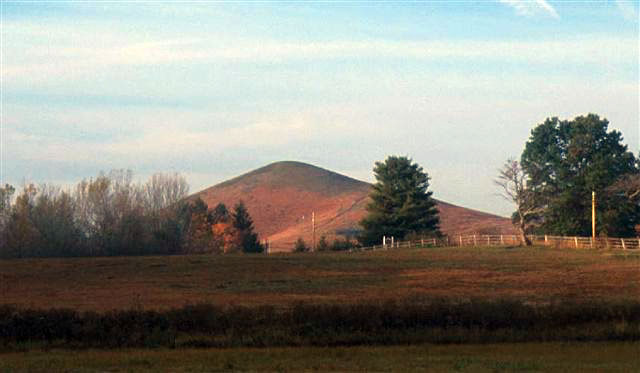
Trimble Knob: A volcanic neck near Monterey in Highland County.
Volcanic eruptions, the most violent of all geological hazards, are extremely unlikely in Virginia in the foreseeable future considering that the most recent eruptions were 47 million years ago (Middle Eocene) and the nearest active volcano is over a thousand miles away. In 2005, the U.S. Geological Survey (USGS) released a comprehensive review of the 169 U.S. volcanoes, ranking the most dangerous threats to humans, and all of them are west of the Rocky Mountains. Even the potential for a significant ash fall generated from a western eruption is remote in Virginia.
However, it should be mentioned that Virginia hosts the youngest known volcanic rocks in the eastern U.S., and both ancient and active geothermal springs occur in Highland, Bath, Augusta, and Rockingham counties. Although these counties could be considered potentially at risk, — the cause of the Eocene magmatism is still debated — the likelihood of a future eruption remains highly remote. The geothermal gradient in this area is regionally consistent, so it is believed that the warm springs originate from deep circulating groundwater that is structurally controlled, rather than being generated by a shallow, still-cooling pluton.
References:
Virginia Tech study on geothermal energy in the eastern US.
Costain, J. K., Glover, L. III, and Sinha, A. K., 1982, Geothermal energy for the eastern United States: Virginia Division of Mineral Resources, Virginia Minerals v. 28, n. 2, p. 13-21.
Costain, J. K., Keller, G. V., and Crewdson, R. A., 1976, Geological and geophysical study of the origin of the warm springs in Bath County, Virginia: U.S. Department of Energy, TID-28271, 184 p.
Ewert, J. W., Guffanti, M., Cervelli, P., and Quick, J., 2006, The National Volcano Early Warning System (NVEWS): U.S. Geological Survey Fact Sheet 2006-3142, 2 p.
Hobba, W. A., Jr., Fisher, D. W., Pearson, F. J., Jr., and Chemerys, J. C., 1979, Hydrology and geochemistry of thermal springs of the Appalachians: U.S. Geological Survey Professional Paper 1044-E, 36 p.
Nolde, J. E., and Gianini, W. F., 1997, Ancient warm springs deposits in Bath and Rockingham Counties, Virginia: Virginia Division of Mineral Resources Virginia Minerals, v. 43, n. 2, p. 9-16.
Perry, L. D., Costain, J. K., and Geiser, P. A., 1979, Heat flow in western Virginia and a model for the origin of thermal springs in the folded Appalachians: Journal of Geophysical Research, v. 84, n. B12, p. 6875-6883.
Reeves, F., 1932, Thermal springs of Virginia: Virginia Geological Survey Bulletin 36, 56 p.
Sammel, E.A., 1979, Occurrence of low-temperature geothermal waters in the United States, in Muffler, L.J.P., ed., Assessment of geothermal resources of the United States – 1978: U.S. Geological Survey Circular 790, 163 p.
Tso, J. L., McDowell, R. R., Avary, K. L., Matchen, D. L., and Wilkes, G. P., 2004, Middle Eocene igneous rocks in the Valley and Ridge of Virginia and West Virginia, in Southworth, S., and Burton, W., eds., Geology of the National Capital Region – Field Trip Guidebook: U.S. Geological Survey Circular 1264, p. 137-161.
U.S. Geological Survey, 2006, Volcano hazards – A national threat: U.S. Geological Survey Fact Sheet 2006-3014, 2 p.
